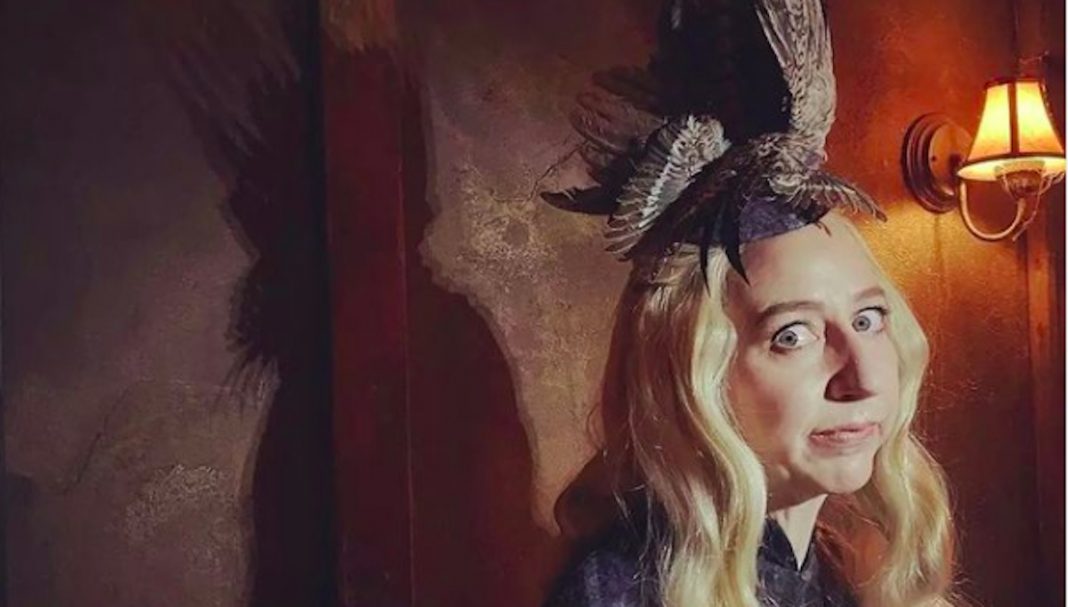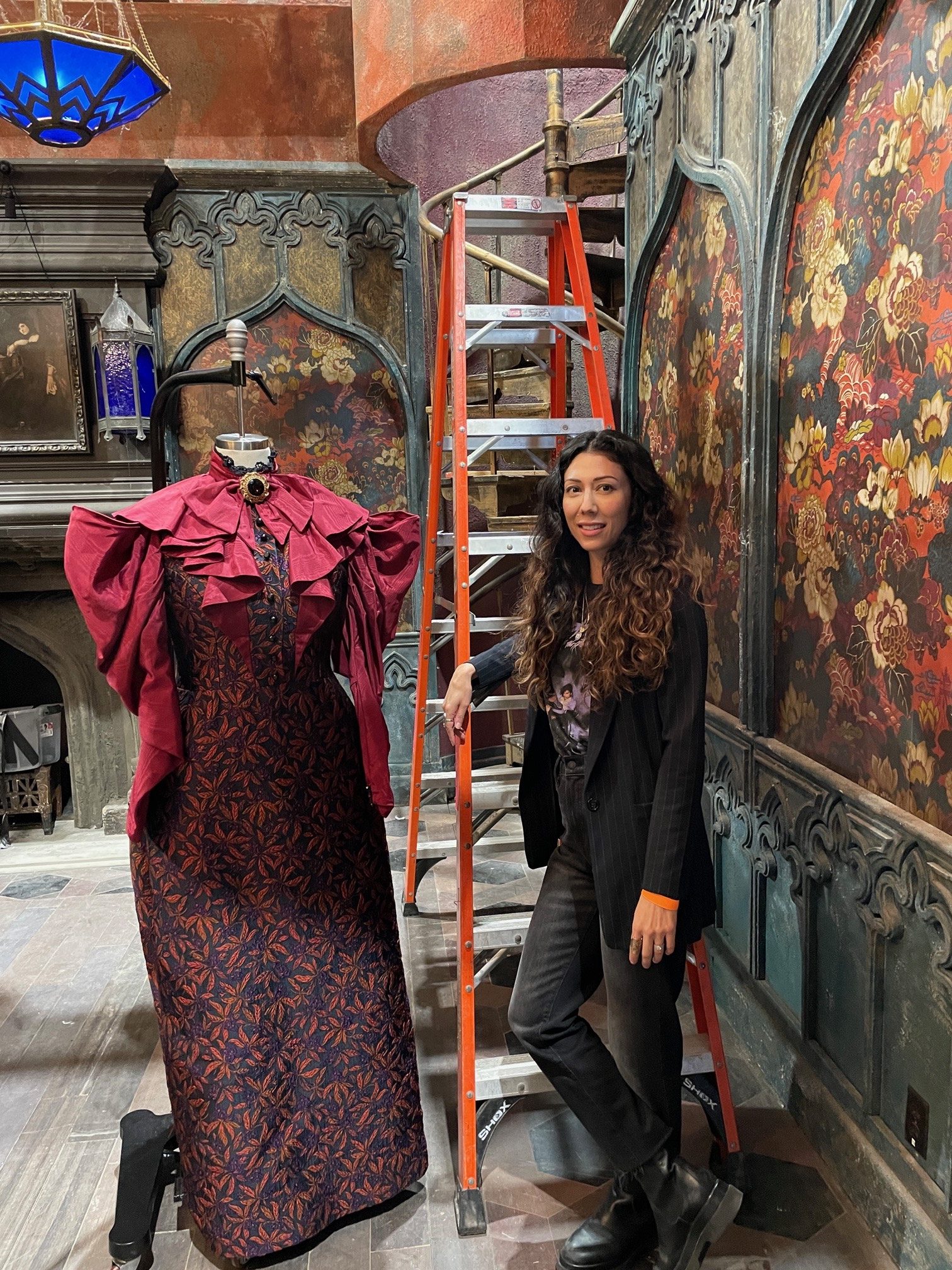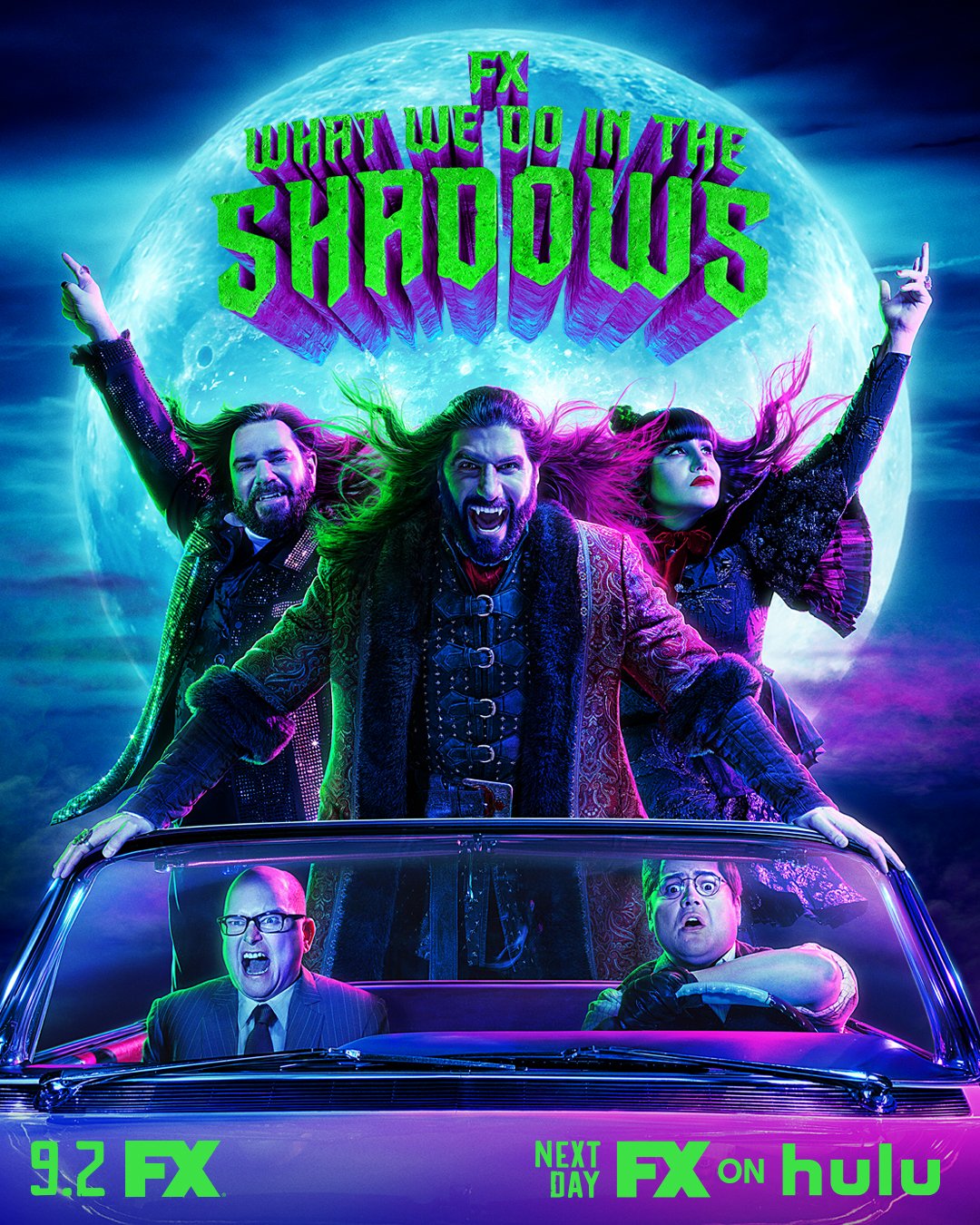In the third season of What We Do in the Shadows, currently airing on FX (and available for streaming on Hulu the next day), the vampire roommates and their loyal bodyguard face another round of supernatural shenanigans… and this time, they’ve been saddled with all the responsibilities associated with the Vampiric Council!
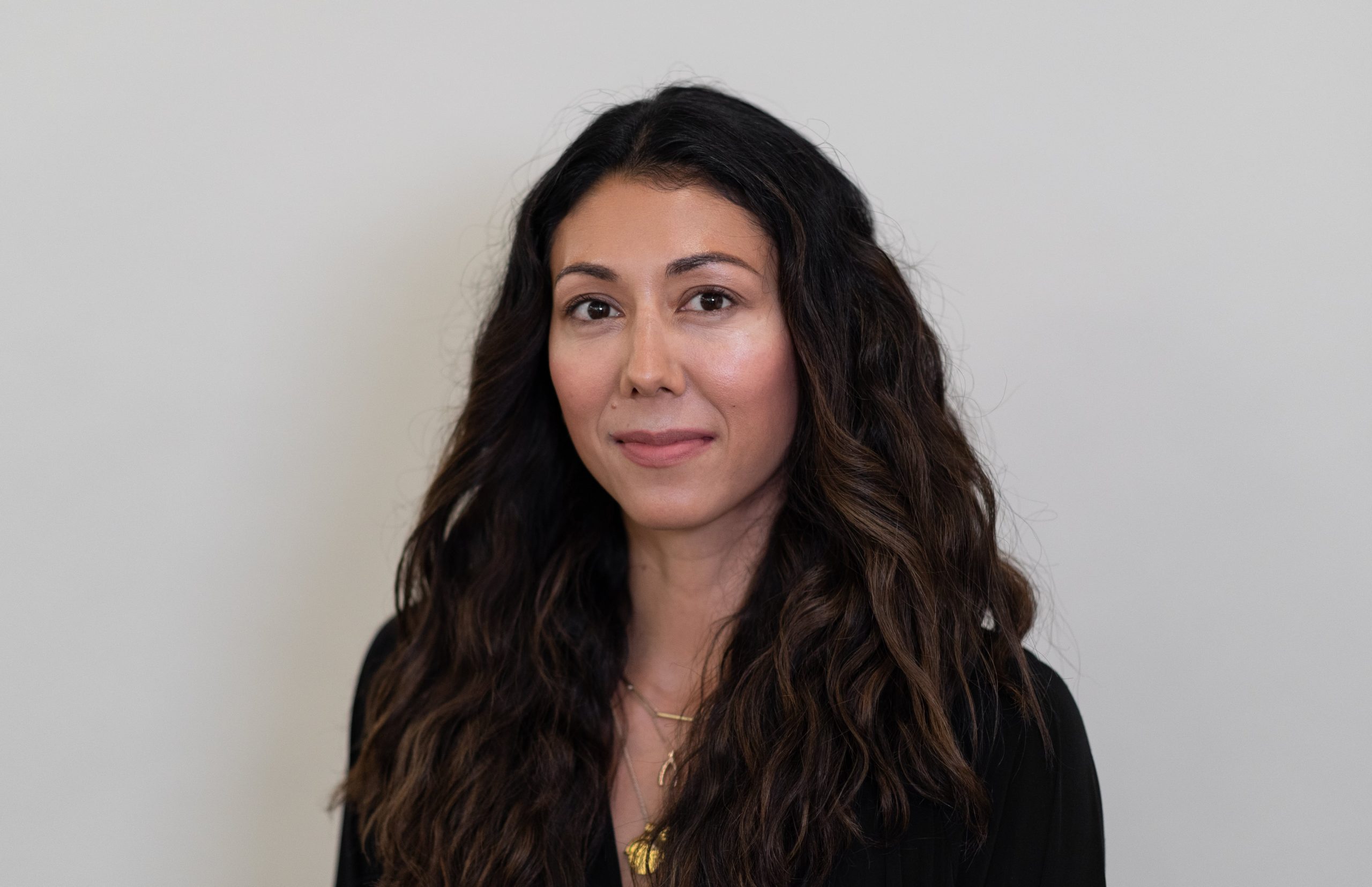
The Beat got the chance to catch up with costume designer Laura Montgomery to learn all about what goes into designing outfits for the undead of different eras, uncover more about the great headwear worn by The Guide (Kristen Schaal), and to find out the difference between costuming for comedic horror and just costuming for horror!
AVERY KAPLAN: Each of the vampires has their own distinctive “vampire style” (even supporting characters like the Millennial vampires in episode 2). What goes into costuming for so many different types of vampires? Is it enjoyable to costume so many different “eras” of clothing?
LAURA MONTGOMERY: It is probably one of the most fun things about the job, actually, the fact that it is not just one period, because I love doing period costuming. It’s really such a luxury to have all these different periods that we can design from!
You don’t often get to do contemporary so the Millennial vampires were really fun. Trendy is not something we usually do on What We Do in the Shadows, so it was kind of our first opportunity to design really contemporary, trendy costumes.
And then for the other vampire day players, sometimes it will be in the script, and other times I’ll get an inspiration for their look. I’ll decide on a period or an origin – we have a character coming up and we know that he’s very old, based on indications in the script.
Usually I’ll try to hone in on: “he’s from the 1500s from Spain,” or, “he’s from the 1700s in Belgium,” and then that really gives us a way to move forward with how that costume is going to be created. And then the research is lots of fun!
KAPLAN: Vampires have lots of superpowers! How much do you have to consider things like “flying around the set” when designing a costume?
MONTGOMERY: We have to consider it quite a lot! Our show has a lot of stunts, as you’ve seen, it’s really action packed, so quite often, when we’re going through and doing our script breakdowns, we’ll make note of when a character is stunted, so I have to know, “I need two of this, I need three/four of this.”
For the Millennial vampire (Tyler Alvarez), we knew his heart was getting torn out of his chest, so whatever we purchased we had to get in multiples, because of the different stages of the action of ripping the heart: the before, the after; getting a size bigger to accommodate the prosthetic underneath…
And even when the actors are doing their own stunts, there’s a lot of bigging involved, because they do so much flying and jumping. So we’ll usually have a costume that is untouched, then a version that’s maybe a little bit bigger or it’s adjustable, so they can have that over the top of their harness.
We’ve done that with The Guide’s character. She does a lot of flying and floating, so she’ll have costumes that we’ll either have two of or they’re adjustable, so we can cut them to get the pick points to get the wires in and they’ll fit over the rig.
KAPLAN: Do you also costume the characters when they appear in “flashback photos”? What’s it like to costume a flashback vampire?
MONTGOMERY: We do – so it’s often a combination of found artwork and costumes for the character. Nandor (Kayvan Novak) has had that a lot, this season and last season. There’ll be a little montage of – this season it was him and Gail, the montage of them dating through the ages.
So the director and the producers will narrow down a list of photos they want to get. Between us and the art department, it will be, “Okay, these are ones that they’re just posting their faces on them – like, if you saw the Atlantic City episode last [week], Nadja (Natasia Demetriou) and the Rat Pack. And I haven’t seen that episode yet, so I don’t know exactly how it turned out or what they used!
Or sometimes it will be totally new photos that we’re kind of re-creating, or pictures where it’s an existing image and we know that we’re going to be putting our cast into the photos, so they have to be posed in a similar way…
And then, in terms of the research… I try not to use too many pieces from the existing closets depending on how far back the flashbacks are going. So it’s still the character, but for Nandor and Gail through the ages, we used a few of his existing pieces, but then pulling things that would be recognizable from the 70s, 80s, and 90s, so it was new clothing that would be contemporary for that period, so it’s an easy read for the audience.
And the same with Nadja and the Rat Pack photo, it was costumes that have more that silhouette, that shape, so she would fit in with the Rat Pack as a quick read.

KAPLAN: This season has featured some incredible pieces, including the headpieces worn by The Guide and the traditional short pants worn by Nandor when he visited the 24-hour gym. Can you tell us about the practical aspects of costuming for the show? How do you go about finding individual pieces?
MONTGOMERY: It’s very different! It involves a lot of research, a lot of kind of keeping your eyes peeled. And then we do a lot of custom building, as well.
So all of The Guide’s headpieces this season were custom built. It had to be; the fit is important and you know, she’s wearing a wig, so it had to fit over her wig.
So for The Guide’s hat, they’ve been working since the first season with this wonderful milliner named Kaz Maxine. I’ll design the headpiece and then collaborate with her with the designs and she builds it, and she does a really great job.
I’ll try to design the headpiece to compliment the costume, so in that first episode where she has that amazing tulle dress and she’s supposed to be the wisp of smoke, we did a kind of Spanish mantilla headpiece, with the lace and it’s see-through, so that goes with the dress.
We did the bird headpiece for her hair ensemble. For that I was thinking, where is The Guide coming from for that scene where she comes up and Colin (Mark Proksch) and Laszlo (Matt Berry) had taken the jalopy out, and they’ve got it outside and they’ve ruined the jalopy room and the Chamber of Curiosities, and I thought, “What does she do in her off hours? Where is she coming from?”
So I decided she was coming from a date! And we also just loved the bird hat for her flying – it was a bit on the nose, but it was also like, “Of course she’s got a bird hat for flying.”
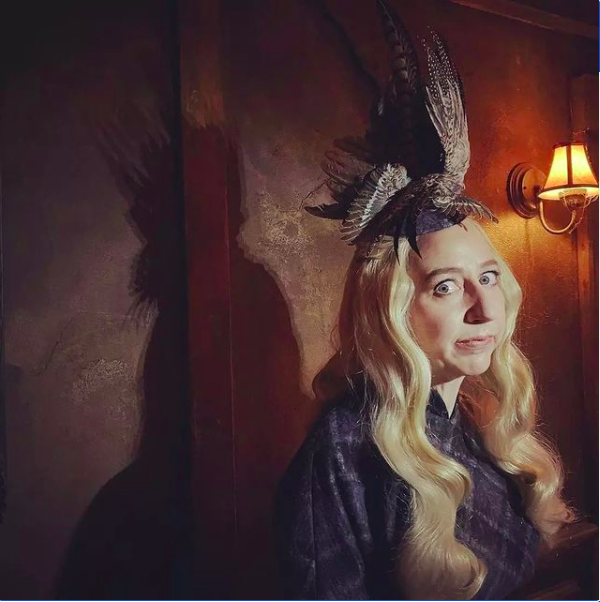
And then Nandor’s pants… This season I really tried to do research into Persian costumes, Persian clothing, Iranian culture and heritage; the actor, of course, Kayvan, is Persian, but the character of Nandor is from his fake country, Al Quolanudar, which is in that region. So I tried to use that for his costume.
For the pants, it’s a uniform worn in traditional Persian wrestling, which is called pahlevan. So it’s existed for a few hundred years, and they are custom-made in Tehran… And through connections and an Iranian girl who works on our team, she was able to communicate with the maker in Farsi for me, and she was able to get some family members to pick them up and hand-carry them on a flight from Tehran to Toronto…
And then of course, they’re brand new when we get them, so we age and distress them so it looks like he’s had these pants for, you know, two hundred years. But they were custom made to his measurements!
And the sport is still practiced today! There were a couple of items that we didn’t use, but a guy who practices locally, we rented some of his own personal – he had a vest and a scarf that we didn’t end up using, but I rented them from him just in case we wanted to add some pieces.
But the scarf had a lot of Qur’an… As it turned out, I got someone to translate it for me, and in Farsi, it was kind of a very religious inscription on it, and I thought, “Oh, it’s a bit sacrilegious to have a vampire wearing…” So we skipped the scarf!
KAPLAN: What We Do in the Shadows is one of the funniest shows on TV, with gags being delivered left, right, and center – including through sartorial decisions! What was your favorite costuming “joke” from this season?
MONTGOMERY: It’s great because there are a lot of them! And I’d like to take credit for a lot of the ideas, but a lot of them are written on the page – it’ll be like “so-and-so enters wearing X, Y, and Z,” and it’s so funny.
We have a character coming in the episode that’s going to air [tonight]… It’s a bit of a spoiler! It’s a character that we’ve seen before. And he is a new vampire and he doesn’t really know how to be a vampire, and they try to make fun of his clothes… so we made him just look absolutely ridiculous.
I was even laughing when I was sketching the costume. And based on our costume meeting, they wrote-in a line about him saying, “Oh, I just went to Hot Topic and they had all this stuff on sale!”
So it’s a very over the top – it’s Blade mixed with cheesy goth! Very ostentatious and very silly, given who his character was – he was a real nerd before, and he shows up trying to look sexy and vampiric, and I think that costume is really funny.
It's Guillermo's game, we're all just chess pieces.
A new episode of #ShadowsFX premieres Thursday. Next day #FXonHulu pic.twitter.com/RncedCkX2x
— What We Do In The Shadows (@theshadowsfx) September 21, 2021
KAPLAN: How does costuming “comedic horror” differ from costuming “traditional horror” (if it does differ)?
MONTGOMERY: It’s funny, it really does! I think for comedy – you know, you always have to be true to the character. So I always want the actors to be able to put on the costume and really feel like their character, even in this world that’s very ridiculous.
Because it’s a mockumentary style, everything has to feel “real,” especially the humans. The humans have to always feel really real… and the vampires, there has to be an integrity and an authenticity to what they’re wearing.
I had a moment, my assistant designer and I were in a fabric store and we were choosing a fabric for Guillermo (Harvey Guillén)’s vest, and there was one that was a brighter color and one that was a bit more muted. I was naturally drawn to the more muted color, because it just worked with the shirt fabrics we had brought with us…
But the pop-ier color was also good, and I looked at it and I was like, “You know what it is? One is comedy and one is drama.” And that’s how we made our decision: we go with the lighter color. There’s more of a lightheartedness to it.
KAPLAN: Did you have an overall favorite costume (or character to costume) this season?
MONTGOMERY: There was something about all of their costumes that was really fun… It’s a lot of men, so when I get to design a costume for the female cast, that is extra special for me.
I think women’s fashion in general can be a lot more interesting than men’s fashion. So The Guide’s character, being able to really build a wardrobe for her this season… She only had one costume when she was with us in the first season!
And also, making her a fashionista and getting to use edgier silhouettes, interesting fabrics, the headpieces… She was one of the first characters that I started with, because I knew I would kind of have to start from scratch with her, and she needed a lot of clothes, whereas the other characters had two seasons worth of stock already.
So starting from scratch with her was lots of fun!

And then, I love Nadja’s costumes as well. Natasha always has great ideas, so it’s lots of fun to collaborate with her and just make really beautiful, beautiful dresses.
KAPLAN: The third season of What We Do in the Shadows was entirely produced during the ongoing COVID-19 pandemic. How did this affect your work and process (if it did)?
MONTGOMERY: It really forced us to pare down in certain ways, which is good because it kind of made decisions easier.
We shoot in Toronto and for a good portion of our season, our city was in lockdown. So there were small periods of time when we were physically able to go into stores, but there were large chunks of time when it was only online shopping.
So that made it a lot harder, for the contemporary characters, especially, for someone like Gail (Aida Turturro) … That was a challenge, because she needed a lot of multiples for her werewolf look, and we can’t go into stores, so it was a lot of online ordering, a lot of online returning…
The actors coming in and being in quarantine, as well, I learned the hard way that Zoom fittings are not great. You really need to be there in person, it doesn’t always work to send someone clothing to try on in their hotel room…
And then it forced us to kind of just make do with what we had. So I was lucky that we had a large fabric stock in our office already, so knowing we didn’t have the option to go purchase any, I was like, “Okay, what do we have here? Can we dye it? Can we beat it?” You know, we don’t have twenty options, we have two options, so we’re going to make one of them work. And then it proved too that it can get done, which is great!
And then the other thing about the pandemic which I was really supportive of: for the safety of the crew, we had shorter working hours. Normally it’s a standard twelve-hour working day on set, but especially in the costume department, it’s much longer because we have parts at the beginning of the day, we have wrap at the end of the day, so it can make for some really long hours.
I know in Europe, they do ten hour days, and I try to do that in the office, because I’m just such a big proponent of work-life balance. I have two young children, so I myself do not want to work sixteen to eighteen hours a day, and I don’t want my crew to have to work those hours, because I think that you need a life outside of work, and if you’re not able to see your family, see friends, go to appointments – you have nothing to bring to work.
We were lucky that our producers were really on-board with that as well, and I think they generally share that attitude of, they want a healthy crew, they want a crew who has a life outside work, and they really support the crew’s safety and wellbeing.
So even though it was the height of the pandemic, we were getting testing three times a week, and we felt really safe. It was definitely a challenge, but proof that we could get it done!
KAPLAN: Is there anything else you’d like me to include?
MONTGOMERY: Just that I love working on the show, and look out for season four, because I think it’s possibly even funnier!
New episodes of What We Do in the Shadows air Thursday night on FX and are available for streaming the next day on Hulu.


